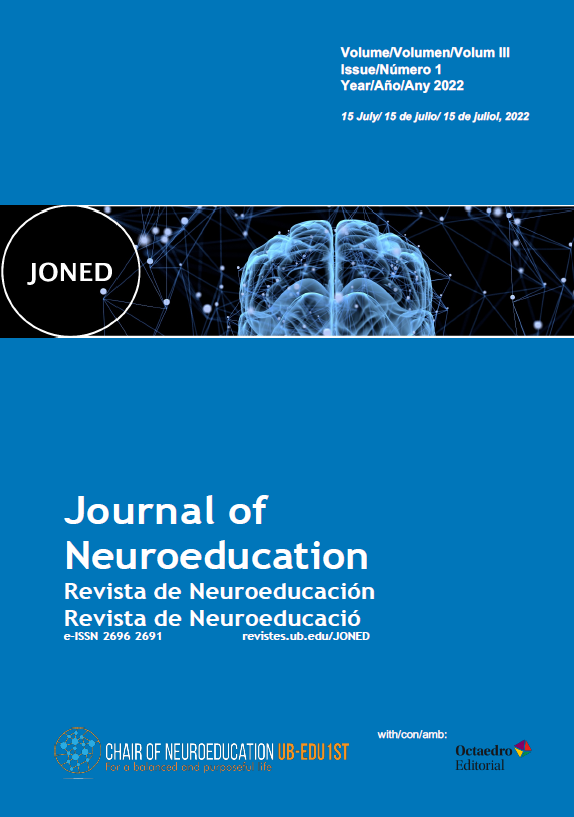Las tecnologías digitales al servicio del diseño universal para el aprendizaje
DOI:
https://doi.org/10.1344/joned.v3i1.39658Keywords:
technologies, UDL, universal design for learning, universal accessibility, digital accessibility, digital content, ICT resources, inclusionAbstract
Technology has uses for a wide range of services, including education, being analyzed by different theoretical models in its application to educational environments. Used from a pedagogical approach, technology must favor the learning of all students based on digital accessibility standards. Accessibility in learning is based on the three principles of UDL (representation, implication and action and expression), principles for which technology provides varied and multiple resources and possible actions, both specifically for each principle and in an integrated way to the three. Technology also allows the design of digital and accessible educational content by configuring parameters alluding to the content itself and its format, with support references to do so and application examples in some educational institutions that have used the UDL approach to design resources. open educational. Given that the use of technology in education also involves associated risks, we must be aware of them in order to avoid them or compensate them in favor of the inclusion of all students.
References
Puentedura, R. SAMR: A Contextualized Introduction. 2013. Ruben R. Puentedura’s Blog. Disponible en http://hippasus.com/blog/archives/112
Mishra, P; Koehler, M. J. Technological Pedagogical Content Knowledge: A Framework for Teacher Knowledge. Teachers College Record, Columbia University. 2006. Vol. 108, Nº 6, pp. 1017-1054. Disponible en https://punyamishra.com/2008/01/12/mishra-koehler-2006/comment-page-1/
Ministerio de Educación y Formación Profesional. Instituto Nacional de Tecnologías Educativas y de Formación del Profesorado. 2022. Actualización del Marco de Referencia de la Competencia Digital Docente. Diponible en https://www.boe.es/eli/es/res/2022/05/04/(5)/dof/spa/pdf
Gobierno de España. Jefatura del estado. Agencia estatal Boletín Oficial del Estado. Ley orgánica 3/2020, de 29 de diciembre, por la que se modifica la Ley orgánica 2/2006, de 3 de mayo de Educación. BOE núm. 340, de 30 de diciembre de 2020, páginas 122868 a 122953. Disponible en https://www.boe.es/diario_boe/txt.php?id=BOE-A-2020-17264
Alba Pastor, C., Zubillaga del Río, A., & Sánchez Serrano, J. M. Tecnologías y Diseño Universal para el Aprendizaje (DUA): experiencias en el contexto universitario e implicaciones en la formación del profesorado / Technology and Universal Design for Learning (UDL): experiences in the university context. Revista Latinoamericana De Tecnología Educativa. 2015. RELATEC, 14(1), 89-100. Disponible en https://doi.org/10.17398/1695-288X.14.1.89
Márquez, A. La rueda del DUA 2020: actualización de recursos para derribar barreras a la participación. 2020. Disponible en https://www.antonioamarquez.com/la-rueda-del-dua-recursos-para-derribar/
Junta de Extremadura. Consejería de Educación y Empleo. Checklist DUA: dualiza tus recursos educativos digitales. Blog emtic (educación, metodología, tecnología, innovación y conocimiento), Disponible en https://emtic.educarex.es/224-emtic/atencion-a-la-diversidad/3235-checklist-dua
UNE, Normalización Española. Norma Española UNE 71362:2020. Calidad de los materiales educativos digitales. Disponible en https://www.une.org/encuentra-tu-norma/busca-tu-norma/norma?c=N0063263
Downloads
Published
Issue
Section
License
Copyright (c) 2022 María de los Milagros Rubio Pulido

This work is licensed under a Creative Commons Attribution-NonCommercial 4.0 International License.
The authors who publish in this journal agree to the following terms:
a. Authors retain copyright and grant the journal the right of first publication
b. Texts will be published under a Creative Commons Attribution Non Commercial License that allows others to share the work, provided they include an acknowledgement of the work’s authorship, its initial publication in this journal and the terms of the license, and not for commercial use.



